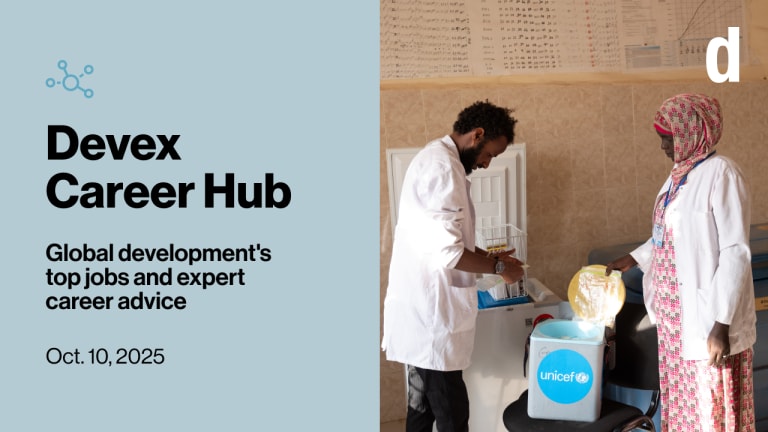How to reset your networking strategy in 3 steps
In order to find true success with your networking efforts, you may need to stop what you’ve been doing and hit the reset button. Expert global development coaches share how to leverage online networking to build the next step of your career.
If you’ve come into this new year feeling frustrated by the results of your networking efforts, there’s a good chance you haven’t reassessed your approach in a while. “People get frustrated when they're not working or in a job search because they're not getting the results they want. And I want to encourage everyone to really stop and look at your techniques and strategies and think, okay, am I doing the same thing and not getting the results I want,” said Jennifer Bangoura, the director of career innovation at Nexford University. Bangoura joined international coach Simone Anzböck during a recent Devex live video event on LinkedIn to discuss best networking practices for global development professionals. One of the key takeaways from this conversation was that instant results are rare when it comes to professional networking, and one has to play the long game and commit to nurturing relationships over time. But in order to start down that path, you may need to stop what you’ve been doing and hit the reset button. The following three steps will get you on the right track. Decide what you want (and who you are) When deciding who to connect with, it’s tempting to take a broad approach that focuses on connecting with as many people as possible. This is especially true on LinkedIn, which makes it easy to reach out quickly and en masse. But focusing on quantity over quality often leads to disappointing results. “If you cast a really wide net and you want to be everything to everyone, you are going to get frustrated and you're going to feel stuck, and this is coming from someone who is a generalist,” Bangoura said. The key to reversing this mindset is to think about the type of work you really want to do, whether it's the sector you want to work in or the skills you want to work with. This will then guide the people you should target in your networking efforts, and how you choose to engage on platforms like LinkedIn. “When it comes to your professional brand or personal brand, you want to think about the three to five things that you want to be, and known for, and maybe you brainstorm it and you actually write it down on a list — and be patient with yourself,” Bangoura said. Get organized Once you have an idea of the types of connections you want to cultivate, you can start to form a plan of action. This includes creating a list — on a spreadsheet, for example — of people that you want to develop meaningful professional relationships with. With quality over quantity in mind, Anzböck recommends keeping this list to under 20 names. During this process, think: “who are your cheerleaders, the people that always support you, or, who are really valuable contacts from your last company or people that you've met on LinkedIn,” said Anzböck, who also emphasized the importance of not neglecting your existing network. “People [often] associate social networking with new people … and I do think there's a lot of power in the people we already have in our network that probably most of us, including me, are not utilizing enough,” Anzböck said. You will also want to spend this time researching relevant events, and collecting links to content that are tied to the topics and people you’re interested in that you can later use to engage with potential new connections on platforms like LinkedIn through connection requests, posts, and comments. Bangoura suggested using Feedly.com for researching and collecting links to content you might want to share. Start engaging Now that you know what you want, and who to connect with to obtain it, you can start taking action. When making connection requests on LinkedIn, the most important thing to do is to personalize your request, Bangoura said. “When I see a personalized message that tells me they listen to a podcast I was on or they saw a post that I wrote, then I am 100% more inclined to accept the request,” she said. “It's not about vanity … It's just actually I am thinking, what value can I add to you? What value are you going to add to my network? Because it is a two-way street.” You should also keep your expectations realistic and remember that it’s about building a relationship over time, not getting an instant job interview. “I think everybody probably knows that analogy, but if you go on a date, you're not going to make a marriage proposal on the first date, and so that's what I would probably say with the first connection request as well,” Anzböck said. You can also start sharing the relevant content you’ve collected through LinkedIn posts and, when appropriate, while commenting on others’ posts. This “shows your interest over time to that person that you're trying to build a relationship with,” Bangoura said. “The most interesting posts and new ideas I get [are] from other people commenting on posts I didn't I don't know about, and I think that's a lot of value you can add by just sharing your expertise,” Anzböck said. Watch the full recording of the Devex Career event: Networking 101 – Pro tips and best practices on LinkedIn.
If you’ve come into this new year feeling frustrated by the results of your networking efforts, there’s a good chance you haven’t reassessed your approach in a while.
“People get frustrated when they're not working or in a job search because they're not getting the results they want. And I want to encourage everyone to really stop and look at your techniques and strategies and think, okay, am I doing the same thing and not getting the results I want,” said Jennifer Bangoura, the director of career innovation at Nexford University.
Bangoura joined international coach Simone Anzböck during a recent Devex live video event on LinkedIn to discuss best networking practices for global development professionals.
This article is free to read - just register or sign in
Access news, newsletters, events and more.
Join usSign inPrinting articles to share with others is a breach of our terms and conditions and copyright policy. Please use the sharing options on the left side of the article. Devex Pro members may share up to 10 articles per month using the Pro share tool ( ).
Justin is a contributing writer and editor who previously led Devex’s careers content strategy. Before joining Devex, Justin served as the managing editor of Springwise, covering sustainable and climate-tech innovation across all business sectors. He also spent over 13 years as an editor and writer for the New York Times, specializing in digital content production and strategy while producing written and multimedia content on a range of topics, including travel, sports, and technology.








